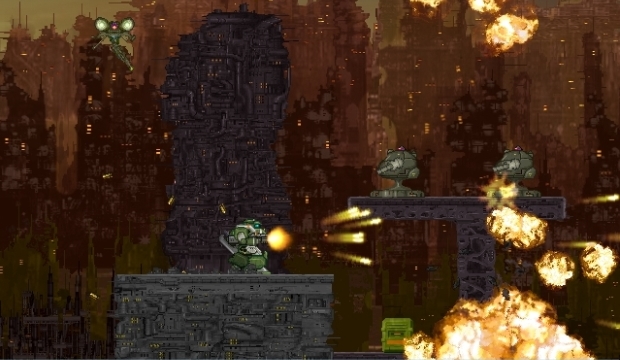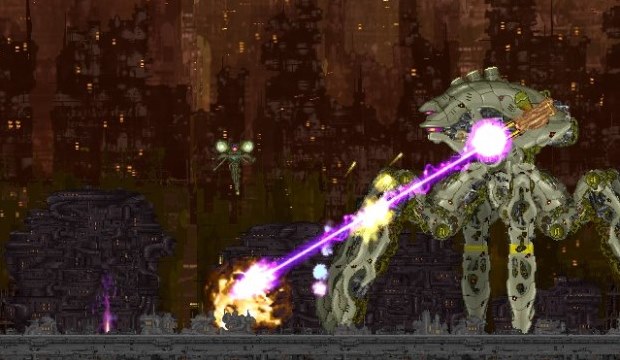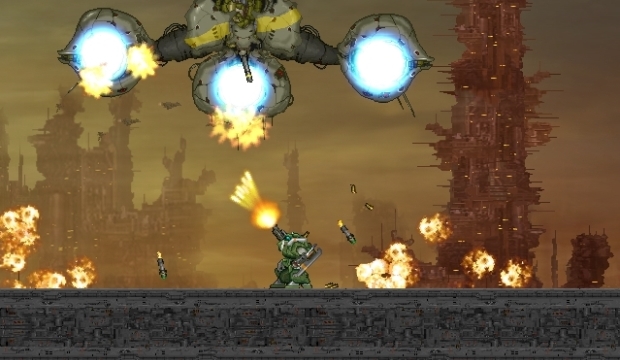Gigantic Army Review
Gigantic Army immediately looks like it would have been perfectly at home on the Super Nintendo or Megadrive consoles of the 16-Bit era. As soon as the first level loads up, its similarities to side-scrolling shooters such as the Contra series will be apparent, and developers NYU media particularly single out Cybernator as one of their biggest influences.
If you didn’t know better you could be forgiven for thinking that Gigantic Army was intended as a sequel to that mech-based shooter. Gigantic Army is a love letter of sorts to the developers at Konami and other Japanese studios in the eighties and nineties, and it doesn’t put on any pretences of being anything more – although it does boast a handful of features and extras which allow it to stand very much on its own two feet.

The storyline is incredibly run of the mill in science fiction terms: earth is at war with an alien species known as the Ramulons (calm down, Copyright Police: it’s Ramulons, not Romulans), who look like something from the Alien movies. The frontline of the war is being fielded by ground troops equipped with MCRs, or Manned Combat Robots, small mechs that make effective stormtroopers.
That is all the story you need really (kill Aliens, win the war) before you are thrown immediately into the action. The gameplay is typical of side-scrolling shooters, with buttons for jump, shoot and special weapons. Your mech can shoot in every direction, even downwards and along diagonal lines, which was popularised by Contra and thankfully means that you can always aim at your enemies no matter where they are on-screen in relation to your character. Rather than resorting to the less forgiving and old-fashioned idea of one-hit kills, your mech has a health bar which allows multiple hits.
This is a very welcome addition as it removes a great deal of frustration from proceedings and allows for some second chances. Something not typical for the genre is your shield. This too can be deployed in any direction to block enemy fire, but also has a bar of its own. Rely on the shield too much and its power will run out , rendering it useless until you find a shield power-up. The inclusion of a shield makes you play the game very differently from many of its fore-bears – injecting more strategy and calling for a more patient approach.

There are also dash and thruster actions, which allow for faster movement through levels, dodging of enemies and more hang-time from jumps. These features only change the gameplay in minor ways, but give it a slightly unique personality. Rather than allow for weapon collectables and hot-switching throughout levels, you choose both your light and heavy weapon loadouts at the start from a selection of six weapons. Some of these complement each other more than the next, and a good balance between power and ammo must be struck. Once chosen, this is your loadout for the entire playthrough, which is a bit of a shame, but simply means you should think carefully before making your choice.
Unfortunately there are only six levels in the whole game. Although they do get progressively longer and more difficult, it would have been nice to have a few more stages to play through. There are thankfully four difficulty levels to choose from though, so you can work your way through them to add length to the title – and the higher difficulties feel a lot closer to the less forgiving titles that Gigantic Army is inspired by.
There is also not a huge degree of variety from level to level, with most of the minor enemies re-used, and similar backgrounds and basic platforming constituting most of them, and although the sprites are detailed and the animation satisfyingly robotic, many of the graphical elements feel too alike and all of the action tends to meld into one big level in your head.

There is a mid-level and end of level boss in each stage and, in true Contra style, these get bigger and more visually impressive as you progress. There is of course a technique and weak point to beating each one, but they all possess the classic imposing quality that all the best shooter bosses traditionally have. They are satisfyingly challenging, so that beating them feels like an achievement, but aren’t as frustrating as some you might remember from classic titles.
VERDICT: Gigantic Army certainly won’t win any awards for being technically proficient or graphically impressive, but what it manages to do is take a well-worn gaming formula and add a few new elements to it – and in doing so, it manages to reduce some of the major bugbears that those frustratingly difficult titles often suffered from. The story and design may not be unique enough to allow the game to stand out and be a hugely memorable experience, but the gameplay itself is very satisfying and not purely a nostalgia trip.

GOOD. A game that scores 7/10 is worthy of note, but unworthy of fanfare. It does many things well, but only a few of them incredibly well and, despite a handful of good qualities, fresh ideas and solid mechanics, it fails to overwhelm.
Review code provided by publisher.




